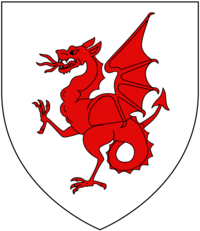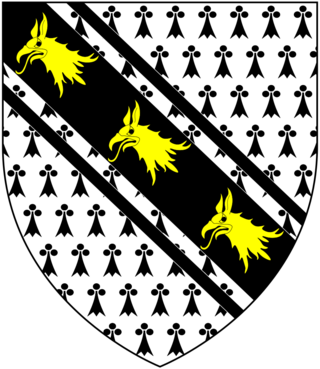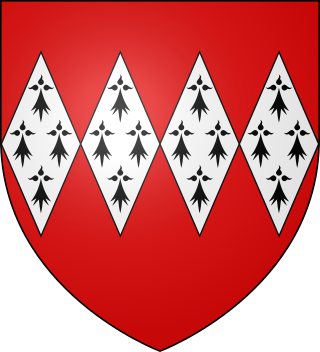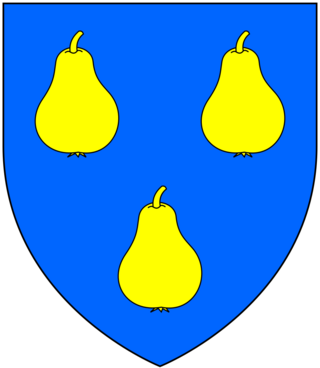


There have been four baronetcies created for people with the surname Drake and Drake-Turner, three in the Baronetage of England and one in the Baronetage of Great Britain.



There have been four baronetcies created for people with the surname Drake and Drake-Turner, three in the Baronetage of England and one in the Baronetage of Great Britain.
The Drake Baronetcy of Buckland, in the County of Devon, was created in the Baronetage of England on 2 August 1622 for Francis Drake, nephew of the privateer and explorer Sir Francis Drake. [4] The first baronet was also a Member of Parliament, as were all his successors. The baronets' seat was originally Buckland Abbey, Sir Francis Drake's home, but upon their inheritance of Nutwell Court, near Exeter, the Drakes ceased to live year-round at Buckland. A daughter of the fourth baronet was the wife of George Augustus Eliott, 1st Baron Heathfield, the defender of Gibraltar, and their descendants ultimately inherited both Buckland Abbey and Nutwell Court. The baronetcy became dormant, and probably extinct, on the death of the fifth baronet in 1794.
The family relationship or otherwise of Drake of Buckland to the more ancient family of Drake of Ash in the parish of Musbury, Devon, is illustrated by the famous story concerning the admiral's choice of armorials. After having received his knighthood, Drake the admiral unilaterally adopted the armorials of the ancient Devon family of Drake of Ash, near Musbury, to whom he claimed a distant but unspecified kinship. These arms were: Argent, a wyvern wings displayed and tail nowed gules. [2] The head of that family, also a distinguished sailor, Sir Bernard Drake (d.1586), angrily refuted Sir Francis's claimed kinship and his right to bear his family's arms. [5] That dispute led to "a box in the ear" being given to Sir Francis by Sir Bernard at court, as recorded by John Prince in his "Worthies of Devon" (1697). Queen Elizabeth, in order to assuage matters, awarded Sir Francis his own coat of arms, blazoned as follows:
Sable a fess wavy between two pole-stars [Arctic and Antarctic] argent, and for his crest, a ship on a globe under ruff, held by a cable with a hand out of the clouds; over it this motto, Auxilio Divino; underneath, Sic Parvis Magna; in the rigging whereof is hung up by the heels a wivern, gules, which was the arms of Sir Bernard Drake."
— Prince, "Worthies of Devon" (1697) [6]
Nevertheless, Admiral Drake continued to quarter his new arms with the wyvern gules. [7] The arms adopted by his nephew Sir Francis Drake, 1st Baronet (1588–1637) of Buckland were, according to Vivian (1895), the arms of Drake of Ash, but the wyvern without a "nowed" (knotted) tail. [8] However the arms used by subsequent baronets, as is visible at Nutwell Court and in its parish church of Woodbury were the new arms granted in 1581 to Admiral Sir Francis Drake (d.1596).
The Drake Baronetcy of Shardeloes, in the County of Bucks, was created in the Baronetage of England on 17 July 1641 for William Drake, a cousin of the Drakes of Ashe discussed below. [9] The only baronet was a Member of Parliament for Amersham, Bucks. The baronetcy became extinct on his death in 1669.
The Drake Baronetcy of Ashe, in the County of Devon, was created in the Baronetage of England on 31 August 1660 for John Drake, briefly a Member of Parliament for Bridport. [10] The first Baronet was followed by his three sons in succession, the last of whom was succeeded by his two sons in turn. The first Baronet's sister, Elizabeth, married Sir Winston Churchill; they were the parents of the first Duke of Marlborough, who was probably born at the Drakes' seat, Ashe House, Musbury, Devon. The baronetcy became extinct on the death of the sixth baronet in 1733.
The Drake Baronetcy of Prospect, in the County of Devon, was created in the Baronetage of Great Britain on 28 May 1782 for Rear Admiral Francis Samuel Drake, son and brother of the Sir Francis Henry Drakes, fourth and fifth Baronets of Buckland. [11] The baronetcy became extinct on his death in 1789.

Walter Yonge (1579–1649) of Great House in the parish of Colyton in Devon, England, was a lawyer, merchant and diarist.
There have been seven baronetcies created for persons with the surname Lawrence, one in the Baronetage of England, one in the Baronetage of Great Britain and five in the Baronetage of the United Kingdom.

There have been three Baronetcies created for persons with the surname Seymour, two in the Baronetage of England and one in the Baronetage of the United Kingdom. One creation is extant as of 2008.

There have been three baronetcies created for persons with the surname Carew, two in the Baronetage of England prior to 1707, one in the Baronetage of Great Britain.

Sir Henry Pollexfen of Nutwell in the parish of Woodbury, Devon, was Lord Chief Justice of the Common Pleas.
Sir Thomas Trayton Fuller-Eliott-Drake, 1st Baronet (1785–1870) was a British Army officer.

The Prideaux Baronetcy, of Netherton in the County of Devon, was a title in the Baronetage of England. It was created on 17 July 1622 for Edmund Prideaux. The third Baronet sat as member of parliament for Liskeard and St Mawes. The fourth Baronet was member of parliament for Tregony. The title became extinct on the death of the ninth Baronet in 1875.
The Fuller-Eliott-Drake Baronetcy, of Nutwell Court, Buckland Abbey, or Monachorum, Sherford, and Yarcombe in the County of Devon, was a title in the Baronetage of the United Kingdom. It was created on 22 August 1821 for the soldier Thomas Fuller-Eliott-Drake, with remainder in default of male issue of his own to his next two younger brothers, William Stephen Fuller and Rose Henry Fuller, and their male issue. Born Thomas Fuller, he was a grandson of George Augustus Eliott, 1st Baron Heathfield, and grand-nephew of the last Drake Baronet of Buckland, and adopted the additional surnames of Eliott and Drake upon his inheritance of Buckland Abbey and Nutwell Court from the second Lord Heathfield in 1813. He was succeeded according to the special remainder by his nephew, the second Baronet, a son of the younger of his two brothers, who had also adopted the additional surnames. The title became extinct upon his death without a male heir in 1916. The second Baronet's only child married the third Baron Seaton, who also adopted the Eliott and Drake surnames.

Sir Francis Drake, 2nd Baronet of Buckland Abbey, Devon was an English politician who sat in the House of Commons variously between 1646 and 1662. He was a Colonel of the Horse, fighting in the Parliamentary army during the English Civil War.

Sir Bernard Drake of Ash in the parish of Musbury, Devon, was an English sea captain. He himself refuted any familial relationship with his contemporary the great Admiral Sir Francis Drake, as their dispute concerning armorials reveals. In fact, Sir Bernard Drake's grandparents John Drake V 1474-1554 and his wife Margaret were also the grandparents of Sir Francis Drake; Sir Bernard being descended from an older son and Francis descended from a younger son.

John Bampfield of Poltimore and North Molton, Devon, England, was a Member of Parliament for Tiverton in Devon (1621) and for the prestigious county seat of Devon (1628-9).

Sir Hugh Pollard, 2nd Baronet was an English soldier and MP elected for Bere Alston in 1640, Callington in 1660, and Devon in 1661. He supported the Royalist cause in the English Civil War.

Sir Francis Drake, 3rd Baronet (1642–1718), of Buckland Abbey in the parish of Buckland Monachorum and of Meavy, both in Devon, England, was elected seven times as a Member of Parliament for Tavistock in Devon, in 1673, 1679, 1681, 1689, 1690, 1696 and 1698.

Nutwell in the parish of Woodbury on the south coast of Devon is a historic manor and the site of a Georgian neo-classical Grade II* listed mansion house known as Nutwell Court. The house is situated on the east bank of the estuary of the River Exe, on low-lying ground nearly contiguous to the water, and almost facing Powderham Castle similarly sited on the west bank. The manor was long held by the powerful Dynham family, which also held adjacent Lympstone, and was according to Risdon the site of their castle until John Dynham, 1st Baron Dynham (1433–1501), the last in the male line, converted it into "a fair and stately dwelling house".

Sir John Dinham (1406–1458) was a knight from Devonshire, England. His principal seats were at Nutwell and Kingskerswell in South Devon and Hartland in North Devon.

Sir William Drake, 4th Baronet (1658–1716), of Mount Drake, and Ashe House, Musbury, Devon, was an English Tory politician who sat in the English and British House of Commons from 1690 to 1715.

Ash in the parish of Musbury in the county of Devon is an historic estate, long the residence of the ancient Drake family, the heir of which remarkably was always called John, only one excepted, for ten generations. It was formerly believed to have been the birthplace of John Churchill, 1st Duke of Marlborough (1650–1722), whose mother was Elizabeth Drake, but was in fact probably in ruins at the time of his birth. The future Duke was however baptised in 1650 in the Chapel at Ash, which had been licensed by the Bishop of Exeter in 1387. Ash was "burnt and demolished" during the Civil War and "lay long in ruins" during which time the family moved one mile away to Trill, Axminster. John Drake (1625–1669), the wartime occupant who had suffered so greatly for the Royalist cause received some recompense at the end of the troubles by being created a baronet by King Charles II on the Restoration of the Monarchy in 1660. Ash was rebuilt "to a greater perfection than it was of before" by Sir John Drake, 2nd Baronet (1647–1684). The last in the male line was Sir William Drake, 6th Baronet, who died without children and bequeathed all his estates to his widow Anne Williams, who remarried to George Speke, MP, and had by him a daughter Anne Speke, who brought the Drake estates, including Ash and the advowson of Musbury, to her husband Frederick North, 2nd Earl of Guilford (1732–1792), who sold them piece-meal to various persons. Ash House survives today as a grade II* listed private residence in much the same form as depicted by Swete in 1795.

Richard Bampfield (1526–1594) of Poltimore and Bampfylde House in Exeter, both in Devon, was Sheriff of Devon in 1576. He began construction of the Tudor era Poltimore House in 1550, and completed the building of Bampfylde House, Exeter, along with The Great House, Bristol one of the finest Elizabethan townhouses in the West Country, in 1590. He is the ancestor of the Bampfylde Baronets and Barons Poltimore.

Sir Hugh Stucley (1496–1559) was the lord of Affeton in Devon, and Sheriff of Devon in 1545. His third son was Thomas Stukley, known as "The Lusty Stucley".

Sir Francis Henry Drake, 4th Baronet (1694–1740) of Buckland Abbey, Devon was a British landowner and politician who sat in the House of Commons from 1715 to 1740.